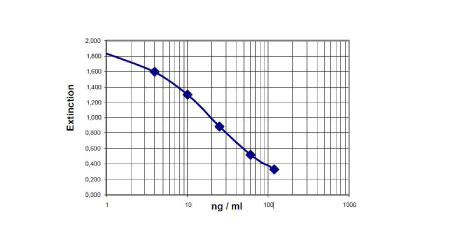25-OH-Vitamin-D ELISA
Vitamin D is a steroid hormone involved in the intestinal absorption of calcium and the regulation of calcium homeostasis. There are two different forms of Vitamin D, named D3 and D2, which are very similar in structure. The D2 is a synthetic product, which is predominantly absorbed by fortified food. Physiological Vitamin D3 levels result not only from dietary uptake but also by biosynthesis of 7-dehydrocholesterol and UV-light in skin because of sun exposure. Vitamin D deficiency can result from inadequate intake coupled with inadequate sunlight exposure, disorders that limit its absorption, conditions that impair conversion of vitamin D into active metabolites, such as liver or kidney disorders, or, rarely, by a number of hereditary disorders. Deficiency results in impaired bone mineralization, and leads to bone softening diseases, rickets in children and osteomalacia in adults, and possibly contributes to osteoporosis. Research has indicated that vitamin D deficiency is linked to colon cancer; conflicting evidence links vitamin D deficiency to other forms of cancer. In the liver, the vitamin is hydroxylated to 25-hydroxyvitamin D (25-OH Vitamin D), the major circulating metabolite of Vitamin D. Although 1,25-(OH)2 Vitamin D portrays the biological active form of Vitamin D, which is synthesized in the kidney, it is widely accepted that the measurement of circulating 25-OH Vitamin D provides better information with respect to patients Vitamin D status and allows its use in diagnose hypovitaminosis . The concentration of 25-OH Vitamin D decreases with age and a deficiency is common among elderly persons. Clinical applications of 25-OH Vitamin D measurements are the diagnosis and therapy control of postmenopausal osteoporosis, rickets, osteomalacia, renal osteodystrophy, pregnancy, neonatal hypocalcemia and hyperparathyroidism. Vitamin D intoxication mostly occurs during a large intake of pharmaceutical preparations of Vitamin D and may lead to hypercalcemia, hypercalcuria and nephrocalcinosis in susceptible infants.
Research topic
Bone and cartilage metabolism
Type
Competitive ELISA, Immobilized antibody
Applications
Serum, Plasma-EDTA, Plasma-Heparin, Plasma-Citrate
Sample Requirements
5 µL/well
Storage/Expiration
Store the complete kit at 2–8°C. Under these conditions, the kit is stable until the expiration date (see the label on the box).
Calibration Curve

Calibration Range
4 – 120 ng/ml
Limit of Detection
1.6 ng/ml
Intra-assay (Within-Run)
n = 40; CV = 5.0 %
Inter-assay (Run-to-Run)
n = 10; CV = 7.8 %
– Mahmoud AA, Khalil Ali AH. Vitamin D receptor gene polymorphism and 25 hydroxy vitamin D levels in Egyptian patients with pulmonary tuberculosis. Egyptian Journal of Chest Dise. 25 March 2014;

